Scolecopteris
synangium stalks – illusory and real ones
As a characteristic feature of marattialean ferns, fossil
and extant,
the sporangia are fused into entities called synangia attached to the
pinnule with a stalk or pedicel which may be so short that it
is
hardly visible. After having seen lots of silicified specimens of
Scolecopteris,
the best known fossil marattialean fern, which is known
with several species, one wonders what to think of the long synangium
stalks of
Scolecopteris elegans
pictured by Zenker [1],
who had described
this species first in
1837 (Fig.1). His observations were based on the
"maggot stones" from the Lower Devonian Döhlen basin, hence the name Scolecopteris,
literally maggot fern.

Fig.1:
"Zenker's
tulip bed": Pinnule with synangia, allegedly with long stalks [1].
The stalks are explained here as artifacts.
The conspicuous stalks in
Fig.1 are certainly not real, as suggested by own finds (Fig.2).
Obviously, Zenker
regarded them as real as he added slender stalks to
all synangia drawings.

Fig.2:
Illusion of slender synangium stalks brought about
by partial decay of sporangium tissue,
the
successive stages of which are preserved in this chert sample from
Döhlen basin with a rare variety of Scolecopteris
with exceptionally small sporangia.
Width of the picture 2mm.
Apparently, the narrow central strand of the broad and very short
pedicel extends between the sporangia, then somehow diffuses and blends
into the inner linings of the sporangia. It is more resistent to decay
than parts of the synangium are, thus appearing as a slender stalk [9].
The
illusion of longer pedicels is also produced by partial decay of
pinnule tissue, as in [2], Fig.11.90, while the true size of the
pedicels is clearly seen on other pinnules in that picture of a sample
from Döhlen basin, the type locality of Scolecopteris, the
"maggot fern".
Judging from
the small fraction of synangia incidentally cut into halves lengthwise
so that the pedicel is distinctly seen, most of the recent
"maggot
fern" finds in Döhlen basin show very short broad pedicels
(Fig.3) like those pictured by Strasburger
[3] in 1875, (Fig.4).
Pinnules with such aspect had been assigned to Sc. elegans
[3,4]. However, pinnule size and venation of own finds lead to the
assumption that pinnules as in Figs.3,4 represent at least one more
species in addition to Sc.
elegans.
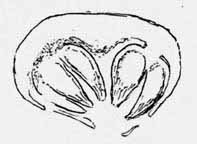
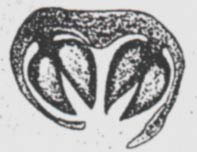
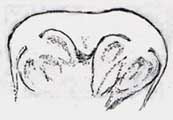
Figs.3-5:
Scolecopteris
pinnule cross-sections with short broad pedicel of the
synangia. Fig.3 (far left): recent find. Fig.4:
drawing in [3], apparently idealized. Fig.5: drawn after lectotype in [4], width
2mm.
Now that the slender stalks have been recognized as
artifacts emerging after decay of surrounding tissue, pinnules with
stout
real stalks (Figs.6-8) from the type locality of the maggot fern
pose a
problem: They differ so much from those seen on the type specimen of
Sc.
elegans (Fig.5) that they
certainly represent another species.
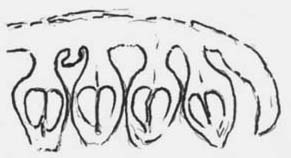
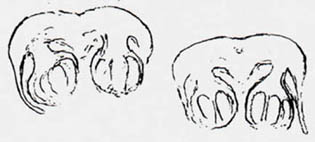

Figs.6-8: Pinnules with conspicuous synangium stalks from the type
locality of Scolecopteris
elegans
but differing distinctly from those of the lectotype
of Sc. elegans
(Fig.5). Figs.6,7: recent finds. Fig.6: cut lengthwise, Fig.7: pinnule
width 1.7mm. Fig.8: offered as Sc.
elegans in [4], Tafel 5, and in [5], Tafel VII; pinnule
width
1.9mm.
Fig.7
leads over to a peculiar discrepancy: Pinnules of similarly odd aspect
(Fig.8) are presented as Sc.
elegans in the very publication [4] where
a sample with pinnules like Fig.5 is declared the lectotype
of
Sc. elegans.
The contradiction
becomes even more obvious by the fact that the veining angle on the
pinnules of Fig.8
is 45° as seen in [4], Tafel 5, and more clearly in [5],
Tafel VII, but that of Sc.
elegans is
about
60°, according to [4]. Ignoring the obvious differences, one of
the authors [4], M. B., insisted on the inclusion of a statement that
there is
"complete agreement of all features" between the specimens seen in
Figs.3-5 and in Fig.8. The
similar statement that there is "most probably only one Scolecopteris
species" in the Döhlen Basin has found its way into a
monograph [7].
So it appears that, by paying attention to
the synangium pedicel, some problems concerning the "maggot fern" Scolecopteris elegans
from the type locality have disappeared but others have emerged, and
conclusions can be drawn which contradict views
repeatedly upheld in the scientific literature:
(1) Very short (<
0.1mm) synangium pedicels as in Figs.3-5 are the most common ones.
(2) Decay of tissue such that the conducting strands are laid
bare produces the
illusion of stalks, which is the cause of the repeated
misinterpretation as slender synangium
pedicels.
(3) Judging from other
features of the foliage it can be concluded that synangia with very
short pedicels represent more than one species.
(4) There is fern foliage with long stout synangium pedicels which
apparently cannot
be derived from the usual short pedicels in any way. Hence they
should be regarded as representing another species.
Finally it can be stated that the presence of possibly three
more maggot
fern species
at the type locality of Scolecopteris
elegans is
suggested by
evidence involving synangia and other features of the foliage. This is
not surprising in view of the fact that 26 Euramerican Scolecopteris
species had been distinguished by 1996 [8], and likely there
will be more. Repeated
attempts
to interpret the variety of shapes as being due to the variability of
one
species appear futile if the available fossils are inspected carefully.
Annotation 2019:
Real long stalks similar to those in Figs.6-8, likewise distinctly
visible in a sample from the classical maggot stone site, had not been
noticed, which led to another misinterpretation in 2015 [10].
Samples: Figs.2,3,6,7: own finds. Fig.3 is drawn after the
sample H2/35.1 pictured in [6], Figs.7,10, there misnamed Pecopteris and with
mistaken scale: The real magnifications are 45x and 10x
instead of 50x and 22x.
H.-J.
Weiss 2011, 2019
[1] E.
Zenker:
Scolecopteris elegans,
ein neues fossiles Farrngewächs mit
Fructification. Linnaea 11(1837), 509-12.
[2] T.N.
Taylor, E.L. Taylor, M. Krings: Paleobotany,
Elsevier 2009.
[3] E. Strasburger:
Über Scolecopteris
elegans ..., Jenaische Z. Nat. N.F.1 Jena 8(1874), 81-95.
[4] M. Barthel,
W. Reichel, H.-J. Weiss: "Madensteine" in Sachsen.
Abhandl. Staatl. Mus. Mineral. Geol. Dresden 41(1995),
117-135, Table 1.
[5]
M. Barthel:
Pecopteris-Arten E.F. v. Schlotheims aus Typuslokalitäten
in der DDR, Schriftenreihe geol. Wiss. Berlin 16(1980), 275-304.
[6] M. Barthel, H.-J.
Weiss: Xeromorphe Baumfarne im Rotliegend Sachsens.
Veröff. Museum f. Naturkunde Chemnitz 20(1997), 45-56.
[7] M.
Barthel:
The maggot stones from Windberg ridge.
in: U. Dernbach,
W.D. Tidwell: Secrets of
Petrified Plants, D'ORO Publ., 2002. p. 65-77.
[8] M.A. Millay:
A review of permineralized Euramerican Carboniferous tree
ferns. Rev. Palaeobot. Palyn. 95(1997), 191-209.
[9] H.-J. Weiss:
Fehlgedeutete
Strukturen in Hornsteinen - alte und neue
Beispiele. 5.
Hornsteintreffen, Museum f. Naturkunde Chemnitz 2006.
[10] M.
Barthel: Die Rotliegend-Flora
der Döhlen-Formation. Geologica Saxonica 61(2), (2015), 108-229.
|
 |
 4 4 |

 4
4








 4
4